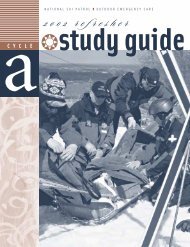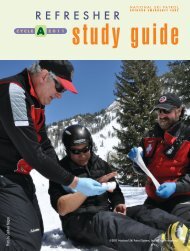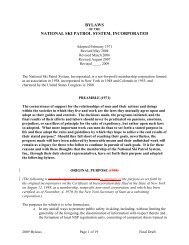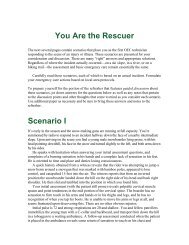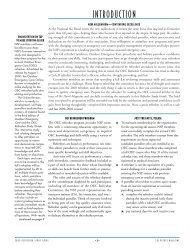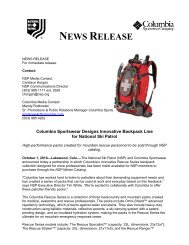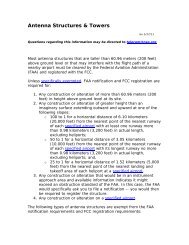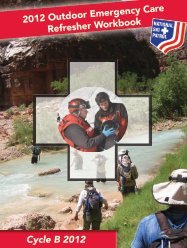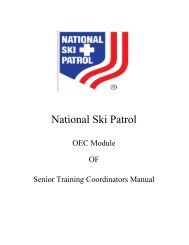You Are The Rescuer Cycle C 2010 (PDF) - National Ski Patrol
You Are The Rescuer Cycle C 2010 (PDF) - National Ski Patrol
You Are The Rescuer Cycle C 2010 (PDF) - National Ski Patrol
- No tags were found...
You also want an ePaper? Increase the reach of your titles
YUMPU automatically turns print PDFs into web optimized ePapers that Google loves.
C<strong>Cycle</strong> <strong>2010</strong>Over the past several years, your refresher committeehas suggested that the best way to present “<strong>You</strong> <strong>Are</strong>the <strong>Rescuer</strong>” (YATR) is in a guided discussion formatin small groups. <strong>The</strong>re are many correct answers and manycorrect methods to solve the scenario. Does the rescueapproach discussed meet the care objective?✚ ✚ I can discuss my possible solution in a guideddiscussion format.✚ ✚ I can listen to other possible solutions.✚ ✚ I can offer constructive feedback to all suggestedsolutions in that guided discussion format.<strong>You</strong> <strong>Are</strong> the <strong>Rescuer</strong>Discussion ResourcesThis year, three scenarios have been selected for the YATRexercise. Additionally, we once again invite you to composeyour own scenario, one that is appropriate to your particularenvironment. Regardless of where the incident occurred—onthe slopes, in the water, or during the summer at an event youattended—the assessment and basic emergency care remainessentially the same. Remember that we are OEC techniciansyear round. As you discuss the scenarios, keep in mind thatthere are many correct answers. “Solving the problem” is notthe primary objective; a guided discussion of all the possiblesolutions is. Try to adapt the presented scenarios to your localneeds and consider your local protocols.Leading questionsAs you approach this patient, what are your priorities?What possible problems do you think the patient may have?What resources might you need to manage thispatient/situation?What emergency care does this patient require?What problem(s) might you encounter as you managethe scene?What are your transport considerations?Discussion pointsDescribe and discuss what you would do to:1. Ensure scene safety;2. Manage the scene; and3. Assess the patient.Identify potential problems/signs and symptoms of each problem.For example:1. Equipment;2. Human resources; and3. Resources needed at base.Describe and discuss:1. Immediate emergency care needs;2. Needs during transport;3. Needs in the patrol room; and4. Important considerations.For example:1. Complications with the patient;2. Crowd control; and3. Challenging terrain.For example:1. From the accident scene to the base facilities;2. ALS/BLS; or3. Air ambulance.How would your emergency care of this patient differ ifyou would have responded to this accident in a differentseason or activity?Refresher Study guide12 <strong>National</strong> ski patrol <strong>2010</strong>
C<strong>Cycle</strong> <strong>2010</strong>Scenario 1 Scenario 2Brigitte Schran-BrownNancy Pitstick<strong>You</strong> and three friends are ice climbing on a popular waterfallthat is reached by hiking up a well-established trail about1.5 miles from the road. It is 28 F on a gorgeous, sunnymorning. As you are roping up to climb one of the smallerroutes on the side of the main fall, you hear a scream. <strong>You</strong> lookup and watch in horror as a climber who was trying to placean ice screw about 15 feet up the main line falls and landsface-down on the icy ground. <strong>You</strong> race to the stricken man’sside just as he struggles to sit up. He is approximately 35 yearsold, appears dazed and is gasping for breath. He is bleedingfrom the nose and mouth. <strong>You</strong> instruct your friend, a fellowOEC technician, to stabilize his head while you do a rapidassessment, which reveals an unstable sternum, an apparenthumeral fracture, and pain in the upper left quadrant. <strong>You</strong> andyour friends are all OEC technicians; none of the other sixpeople standing around have any first aid training. What doyou do?Notes<strong>You</strong> are driving down a two-lane road at 45 mph on yourway to the resort when a car driving towards you suddenlyswerves to the shoulder, makes a U-turn, and races past you.Just as you are muttering disgust for the hair-brained maneuver,he slams on his brakes and stops in the middle of the road.<strong>You</strong> then see the cause of his seemingly erratic drivingbehavior. A pedestrian is lying in the middle of a crosswalkand is not moving. Traffic is heavy, but most vehiclesimmediately pull to the side of the road. <strong>You</strong> run up theroad to the scene to offer assistance.As you approach the scene, you see an approximately 75year old woman in a running suit and shoes sprawled in acontorted manner in the middle of the crosswalk stripes; sheis not moving. <strong>The</strong> erratic driver is leaning over the woman,apparently checking for a carotid pulse. As you approach, youidentify yourself as a ski patroller to anyone who is listeningand offer to help. <strong>The</strong> man says he is a First Responder. <strong>You</strong>note that there is blood coming from the woman’s mouth andnose, and she is making gurgling sounds as she breathes. <strong>The</strong>reis severe mid-shaft angulation in her lower right leg and rightforearm. <strong>The</strong> man tells you that she has no carotid pulse and asksyou to help turn her supine to start CPR; however, you notethat she is continuing to breathe regularly and her neck is verycontorted. A quick check of her radial pulse reveals a strong,rapid pulse, which you communicate to the First Responder.With that information, the First Responder backs off fromthe scene and leaves. A large crowd from the neighborhoodis rapidly forming and two people have taken over trafficcontrol. <strong>The</strong>y tell you they have called 911.Refresher Study guide13 <strong>National</strong> ski patrol <strong>2010</strong>
C<strong>Cycle</strong> <strong>2010</strong>Scenario 3Jennifer BryanIt is a cold, wet day at your ski area. Rain has been fallingfor most of the day, and the runs, walkways, roofs and mostsurfaces are coated in a thick sheet of ice. <strong>Are</strong>a managementhas opted to close some runs and lifts because of the conditions,but the hill and patio beside the main lodge are still crowdedwith skiers and snowboarders. As you take a break and headinto the lodge for a cup of cocoa, you hear a loud crash,followed by screams. <strong>You</strong> and your partner race back outsideto find that a huge slab of ice has avalanched off the roof wellpast the rope line. <strong>The</strong>re is still a large slab of ice partiallyhanging over the roof. As you survey the scene, you see sevenpeople in the crash zone. One woman is lying unconsciouson the ground. A mother who appears uninjured is standing,cradling a five year old to her; the child is screaming andbleeding from multiple facial abrasions. To your horror,you see your own 13 year old son sitting on the ground notfar from the unconscious patient; he gets up and walks toyou, crying. He tells you that ice hit him in the middleof the back and it hurts between his shoulder blades.One of his friends stumbles towards you and tells youshe was hit in the chest with a large chunk of ice andshe is having trouble breathing. A middle-aged couplealso appears to have been struck as they were pulling their skisfrom the rack; they both tell you that chunks of ice strucktheir arms and hands.<strong>You</strong> stand well away from the rope line and call out loudly,“Anyone who can hear me and can walk, come towards meto this table!” <strong>You</strong> order all other public to stand back. Allbut the unconscious woman respond.NotesRefresher Study guide14 <strong>National</strong> ski patrol <strong>2010</strong>
C<strong>Cycle</strong> <strong>2010</strong>To challenge you in a slightly different way, we are askingyou to write your own scenario. Imagine a specific locationat your home area where a significant event could happen.Keeping in mind the cycle-specific topics for this year’srefresher, imagine a worst-case scenario. What type ofincident could happen at this location? What difficulties orchallenges might you face as first on scene? Incorporate localprotocols or procedures into this exercise. If there are any newprotocols or procedures specific to your area that are beingintroduced or reviewed, use this opportunity to discuss them.Take into consideration the gender, age, and physicalcondition of your patient or patients. What would the weatherbe like? Would the accident be due to a collision, a fall, or amedical condition? How much help would you have available?What type of equipment would be available or needed? Howwould equipment get to the scene? How soon would helparrive? If it would help, sketch what the scene would looklike upon your arrival (similar to the photos provided in the“YATR” scenarios).Scenario 4Write <strong>You</strong>r OwnDescribe the condition of your patient(s) and what youwould expect to find in your assessment. Note how thepatient’s condition could change if adequate help was notreadily available. Refer to the points for discussion in the otherscenarios and apply them to your scenario. Think about themajor topics of concern, including scene safety, assessment,emergency care (equipment and assistants), extrication andtransportation. Be realistic here, and have some fun with it;you never know when your scenario might actually happen.If you are describing a scenario you already encountered,feel free to share it with your fellow rescuers and discuss it.Also, ask your instructors if they might stage this incident ata future training session or on-hill clinic. As an alternative,if you would prefer to write up an actual incident for yourrefresher course that occurred at your area (one that fallsinto the topic areas being covered in this <strong>Cycle</strong> C refresher),feel free to do so. Try to choose one that was challengingfor you.Refresher Study guide15 <strong>National</strong> ski patrol <strong>2010</strong>




